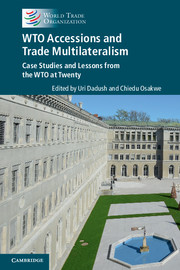Book contents
- Frontmatter
- Dedication
- Contents
- List of contributors
- Foreword
- Acknowledgements
- List of abbreviations
- Editors' note
- PART I WTO accessions, the trading system and the global economy
- PART II Overview: systemic outcomes from accessions
- PART III Members’ perspectives on accession negotiations
- Original members
- 12 WTO accessions from a member's perspective: safeguarding the rules-based system
- 13 WTO accessions: a market access perspective on growth – the approach of the European Union
- 14 WTO accessions: a rules perspective on growth – the approach of the European Union
- 15 WTO accession negotiations: trends and results in agriculture plurilaterals
- Article XII members
- PART IV Working party chairpersons’ perspectives on accession negotiations
- PART V Salient features inWTOAccession Protocols
- PART VI Conclusion
- Annex: Contributor biographies
- Index
- Plate section
12 - WTO accessions from a member's perspective: safeguarding the rules-based system
from Original members
Published online by Cambridge University Press: 05 November 2015
- Frontmatter
- Dedication
- Contents
- List of contributors
- Foreword
- Acknowledgements
- List of abbreviations
- Editors' note
- PART I WTO accessions, the trading system and the global economy
- PART II Overview: systemic outcomes from accessions
- PART III Members’ perspectives on accession negotiations
- Original members
- 12 WTO accessions from a member's perspective: safeguarding the rules-based system
- 13 WTO accessions: a market access perspective on growth – the approach of the European Union
- 14 WTO accessions: a rules perspective on growth – the approach of the European Union
- 15 WTO accession negotiations: trends and results in agriculture plurilaterals
- Article XII members
- PART IV Working party chairpersons’ perspectives on accession negotiations
- PART V Salient features inWTOAccession Protocols
- PART VI Conclusion
- Annex: Contributor biographies
- Index
- Plate section
Summary
ABSTRACT
Forms of collective action and balanced commitment through negotiations were the foundation of the General Agreement on Tariffs and Trade (GATT) and the structure for its daily work. These remain at the centrepiece of work in the WTO, in a system structured on the balance of rights and obligations. GATT contracting parties established the principles of balance and reciprocity, trade liberalisation and a system of mediation and dispute settlement for mutual resolution of GATT provisions. From this base, expansion of membership, pursuant to accession negotiations, has required a commitment to accepting GATT/WTO rules resulting from previous negotiations. WTO accession supports applicants' efforts for economic reform and integration into world markets. This is one of the most important benefits of membership. Although challenging, accession negotiations and the implementation of WTO provisions support important economic goals such as sustainable growth, the promotion of high-tech industries, attraction of foreign direct investment, raised living standards and global assertion of national trade interest.
For over sixty-five years, nations have worked together to create a legal-diplomatic framework for international trade that can expand their market horizons beyond bilateral and regional agreements. The 1947 General Agreement on Tariffs and Trade (GATT) was the result of such an effort, intended to create an agreed structure of rules within which badly needed post-Second World War trade liberalisation could be safely undertaken. There was hope in the 1940s that the GATT would be soon replaced with a more elaborate trade organisation, one that could stand with the World Bank and the International Monetary Fund (IMF), to support economic development and growth. However, the GATT framework of thirty-eight articles was all there was for almost fifty years. Within this simple framework of mutual commitment, the contracting parties to the GATT met periodically to elaborate principles for conducting international trade with the objective of implementing, for themselves and for future contracting parties, the benefits and obligations outlined in its text. They established the principles of balance and reciprocity in the application of trade measures. They sponsored additional multilateral efforts at trade liberalisation, i.e. ‘rounds’ of tariff liberalisation. They created fora for discussion between trade negotiating sessions which became accepted multilateral institutions. They established a system of mediation and dispute settlement to ensure that questions about GATT provisions could be mutually settled.
- Type
- Chapter
- Information
- WTO Accessions and Trade MultilateralismCase Studies and Lessons from the WTO at Twenty, pp. 397 - 400Publisher: Cambridge University PressPrint publication year: 2015



